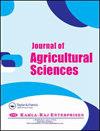Identification of Barley Landraces and Wild Barley (Hordeum spontaneum) Genotypes Resistant to Rhynchosporium commune
IF 0.7
Q3 AGRICULTURE, MULTIDISCIPLINARY
引用次数: 7
Abstract
Barley scald is caused by the fungal pathogen Rhynchosporium commune. This disease causes substantial losses in barley production areas of the world. In this study, seedling resistance of 198 barley landraces, 104 wild barley (Hordeum spontaneum) genotypes and two susceptible Turkish cultivars (Bülbül 89 and Efes 3) to 6 R. commune isolates was assessed in greenhouse experiments. Virulence differences among the R. commune isolates were observed. One sixrowed barley landrace (Yeşilköy 9052) was resistant to all six isolates. Another six-rowed barley landrace (genotype no 17) showed resistant reaction to 5 isolates. Fourteen barley landraces were resistant and susceptible to 4 and 2 isolates, respectively. Twenty seven genotypes of H. spontaneum numbered as 5, 6, 7, 8, 9, 11, 16, 20, 30, 31, 36, 37, 48, 50, 51, 56, 58, 59, 60, 62, 67, 79, 80, 83, 90, 94 and 101 were found resistant to all six isolates of R. commune. Apart from these genotypes, 19 genotypes numbered as 1, 2, 32, 33, 34, 42, 43, 49, 52, 64, 66, 76, 77, 78, 96, 97, 102, 104 and 107 showed resistance to 5 isolates and susceptibility to only 1 isolate. Two susceptible Turkish cultivars Bülbül 89 and Efes 3 were found susceptible to 96% of the scald isolates. Resistant barley landraces and Hordeum spontaneum genotypes can be used as sources of resistance against R. commune.大麦地方品种和野生大麦抗小麦病基因型的鉴定
大麦烫伤是由真菌病原菌舌孢菌引起的。这种疾病在世界大麦产区造成重大损失。以198个地方大麦品种、104个野生大麦(Hordeum spontanum)基因型和2个土耳其品种(b lb l89和Efes 3)为材料,在温室试验中对6株稻瘟病菌的抗性进行了评价。观察了不同分离株的毒力差异。一个六横大麦地方品种(Yeşilköy 9052)对所有6个分离株均有抗性。另一个6棱大麦地方品种(17号基因型)对5个分离株表现出抗性反应。14个大麦地方品种分别对4个和2个分离株产生抗性和敏感。发现27个基因型分别为5、6、7、8、9、11、16、20、30、31、36、37、48、50、51、56、58、59、60、62、67、79、80、83、90、94和101对所有6个分离株均有抗性。此外,1、2、32、33、34、42、43、49、52、64、66、76、77、78、96、97、102、104和107等19个基因型对5株分离物均有抗性,仅对1株分离物敏感。两个敏感的土耳其品种 lb l89和Efes 3对96%的烫伤菌株敏感。抗病的大麦地方品种和天然大麦基因型可作为抗小麦病的来源。
本文章由计算机程序翻译,如有差异,请以英文原文为准。
求助全文
约1分钟内获得全文
求助全文
来源期刊

Journal of Agricultural Sciences
AGRICULTURE, MULTIDISCIPLINARY-
CiteScore
1.80
自引率
0.00%
发文量
0
 求助内容:
求助内容: 应助结果提醒方式:
应助结果提醒方式:


